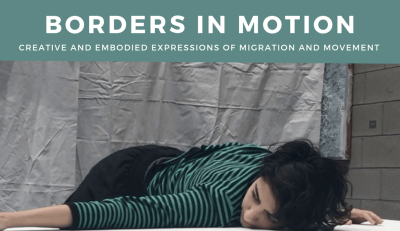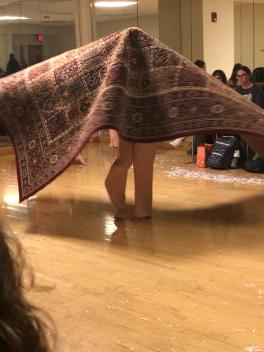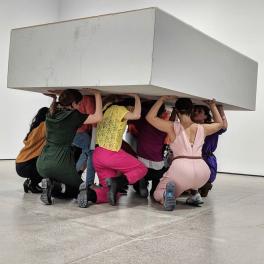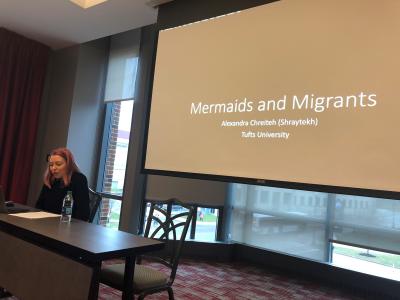
In 2018 Assistant Professor of French, Lucille Toth, started working on On Board(hers), an all-women dance based on testimonies of female immigrants. One of the participants of the dance was Johanna Sellman, Assistant Professor of Arabic Literature in the Department of Near Eastern Languages and Cultures. As Toth and Sellman discussed common interests on borders, movement, and immigration, they formed the basis and goals of a symposium on “Borders in Motion.”

This two-day symposium explored the border in its physicality and as a symbol through literary narratives, dance, food studies, African studies, music, and visual art, and in spaces ranging from the Mediterranean, Palestine, Lebanon, and Iran to Columbus, OH. The symposium began on March 28th with an artist talk by Palestinian author and artist, Leila Abdelrazaq. Abdelrazaq discussed her views on borders, nationalism, and national identity, and the way those views are reflected in her creative work. The talk generated an interesting discussion with an audience from many different parts of Ohio State. In the evening, over 160 guests attended the second event of the symposium, an Open Rehearsal of On Board(hers) at the Beeler Gallery in downtown Columbus. “The show is really about the wall,” explains Toth, “What is the physical burden of lifting the actual wall?”

The symposium continued on March 29th with a screening of the short film Eye and Mermaid (Ameen 2013) and a presentation by author and scholar Alexandra Chreiteh. This was followed by two academic presentations. Badou Fall, a Ph.D. student in French and Francophone studies, presented his research on “Deconstructing Borders: Migritude and Linguistic Barriers in African Studies.” Harry Kashdan, Post-Doctoral Researcher in the Global Mediterranean, discussed “Borders on the Table: Culinary Exchange and Commensality in the Mediterranean.” The afternoon opened with the solo performance Dam Noosh, created by movement artist, dance teacher, and music composer Bita Bell. Dam Noosh is an autobiographical narrative that struggles to transcend boundaries of identity. The symposium closed with a panel discussion by Toth, Bell, and Sellman.

One of the main goals of the symposium was to explore its subject through a variety of voices, angles, and media. The success of this goal was reflected not only in the line-up of events, but also in the diversity of the audience. The symposium attracted guests and questions from Ohio State and from the Columbus community at large. Some attended because of their academic interests. Others wanted to be engaged in the artistic experience. Students represented the undergraduate, graduate, and international population. Many participants shared personal experiences that related to the topics explored in the events.
The Borders in Motion Symposium brought together academics, art, movement, and the community. Guests participated for academic as well as personal reasons. “As academics, we can also be activists and artists,” said Toth. Toth is considering organizing the symposium again next year. She is thinking about ways in which she can make the experience even more engaging and interactive for the audience.
